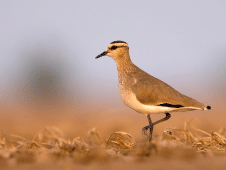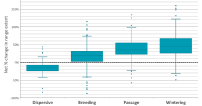
African-Eurasian migratory waterbirds rely on a network of wetland sites within and between their breeding and wintering ranges. Climate change is predicted to alter the suitability of these sites, causing species’ ranges to shift. Species distribution models show that, within this group, dispersive species in the Afrotropical realm and migratory species in the breeding season are projected to suffer the greatest net losses in suitable habitat. Habitat suitability is predicted to decrease at over half of Critical Sites for these species. Therefore, carefully planned, coordinated conservation actions will be required to ensure the climate resilience of wetland species and their habitats.

Every year, over 70 million waterbirds migrate between Europe, the Middle East and Africa (Wetlands International 2018, cited in Breiner et al. 2021), using a network of wetland sites within and between their breeding and wintering ranges. The Agreement on the Conservation of African-Eurasian Migratory Waterbirds (AEWA), established under the Convention on Migratory Species, aims to maintain this network of key sites and habitats for the long-term conservation of waterbirds.
Climate change poses a challenge to migratory waterbird conservation, as changes in the climatic suitability of sites are likely to cause species distributions to shift, altering species composition at each site. For some species, the loss of suitable sites may be compensated by other sites becoming suitable. However, other species may suffer net losses in their range, increasing their risk of local or even global extinction. Establishing a climate-resilient network of wetland sites along flyways is therefore a conservation priority.
Coordinating conservation actions along entire flyways requires understanding the effect of climate change on species and habitats at each stage of the annual cycle. Nagy et al. (2021) used species distribution models to assess the exposure to climate change of dispersive and migratory waterbird species in the African-Eurasian flyways during the breeding, passage and wintering seasons. They found that dispersive species in the Afrotropical realm and migratory species in the breeding season, particularly waders that breed in the Arctic, are projected to lose the greatest proportion of their current range. In total, 60 species are projected to lose more than 30% of their current range by 2050. These species are also projected to be most limited in the availability of newly suitable sites outside of their current range, and are therefore expected to suffer a net loss in range extent. Overall, 84% of dispersive species are predicted to suffer a net reduction in the extent of their range by 2050, with 18% suffering a net loss of more than 30% of their range. Conversely, most migratory species are predicted to undergo range expansions in all seasons (Figure 1).
In the area covered by AEWA, a network of over 3,000 ‘Critical Sites’ has been identified, each of which holds significant numbers of a globally threatened waterbird species or holds >1% of the population of any particular waterbird species. Breiner et al. (2021) found that projected climate change will reduce habitat suitability for waterbirds at 58% of existing Critical Sites within the AEWA area by 2050, with strong geographical variation. Most of the sites predicted to suffer the greatest deterioration in habitat suitability are in Africa and the Middle East and are not legally protected. These sites will see increasing specialisation, with fewer species but a greater need to conserve wetland habitats for persisting species that are unable to disperse, and to facilitate the dispersal of populations to other sites. However, as many of these sites are in low GDP countries with less effective governance, there is much less capacity for conservation action. Sites with projected increases in habitat suitability are predominantly located in Russia and Kazakhstan. These sites will require strict protection and expansion to facilitate colonization by species emigrating from areas that are no longer suitable.
Critical Sites support <10% of the population for the vast majority of AEWA species during the breeding season (Nagy et al. 2021), so protection and management of Critical Sites alone is unlikely to compensate for the effects of climate change. Successful conservation of AEWA-listed species will require a broader network of sites, expansion of protected area networks and wider habitat conservation measures.
Related Case Studies in other sections
References
Breiner, F, T., Anand, M., Butchart, S. H. M., Flörke, M., Fluet-Chouinard, E., Guisan, A., Hilarides, L., Jones, V. R., Kalyakin, M., Lehner, B., van Leeuwen, M., Pearce-Higgins, J. W., Voltzit, O. & Nagy, S. (2021) Setting priorities for climate change adaptation of Critical Sites in the Africa-Eurasian waterbird flyways. Glob. Change Biol., 28(3):739-752
Nagy, S., Breiner, F. T., Anand, M., Butchart, S. H. M., Flörke, M., Fluet-Chouinard, E., Guisan, A., Hilarides, L., Jones, V. R., Kalyakin, M., Lehner, B., Pearce-Higgins, J. W. & Voltzit, O. (2021) Climate change exposure of waterbird species in the African-Eurasian flyways. Bird Conserve. Int., 1-26.
Compiled: 2022 Last updated: 2022
Recommended Citation:
BirdLife International (2022)
Climate change is projected to cause range shifts in African-Eurasian migratory waterbirds, posing a challenge for wetland conservation.
Downloaded from https://datazone.birdlife.org/sowb/casestudy/climate-change-is-projected-to-cause-range-shifts-in-african-eurasian-migratory-waterbirds on 22/12/2024